Ballet exercises you can also do at home:
5 ballet exercises to do yourself

By Olga Leibrandt Last updated: June 24, 2023 Ballet Guide 10 min read
On this page I show you 5 ballet exercises to do at home:
The exercises are intended as a supplement to regular ballet lessons and do not replace ballet training in ballet school. Corrections by the teacher are very important! For all exercises listed, it is important to ensure correct posture (e.g. with a mirror or by having a second person check it), keep your back straight , warm up beforehand and start the exercises slowly at first .
If you have any doubts about the correct execution: Please consult your ballet teacher!
Preparation: For your exercises you need the following:
- Enough space to move and stretch freely.
- A smooth and non-slip surface to prevent injuries.
- Comfortable clothing that allows you to move freely
- A mirror to check form and technique.
- Optional: A ballet barre or a sturdy support such as a chair back, siteboard or wall
- Optional: Appropriate music for background music

Pliés :
Pliés (literally "bent") are a basic ballet exercise that strengthens leg muscles and posture. Here is a more detailed guide on how to do plies at home:
It starts with learning demi-plies (small squats), then progressing to grand plies (big squats). Pliés are performed in all 5 ballet positions in the following order: 1st position, 2nd position, 3rd position, 5th position. The 4th position is learned last, as it is the most difficult position. Pliés are first practiced on the barre, then without the barre in the middle.
Basic rules for performing pliés:
- Distribution of body weight on both feet and the entire ball of the foot
- External rotation is from the hips (not just knees)
- The knees bend directly over the toes
- The heels stay on the ground for as long as possible (in the grand plié) to maximize the stretch in the tendons of the foot
- Heels rise slowly
- When stretching, put your heels on the floor first, then straighten your knees
- The pelvis does not tilt backwards or forwards, but goes down exactly in the middle
- Correct posture is important: back straight and stretched
- Bending and stretching take the same amount of time
Pliés seems like a simple and not so important exercise; But this is not the case! It helps to develop the tendons and ligaments of the ankle, creates muscle energy, springiness of the legs and teaches to properly distribute body weight, which is very important in dancing. This is an important basic exercise in all dance and sports. Before you start the exercise, please watch the Plie video:
Video of Ingrida Ballet Training "Plie"
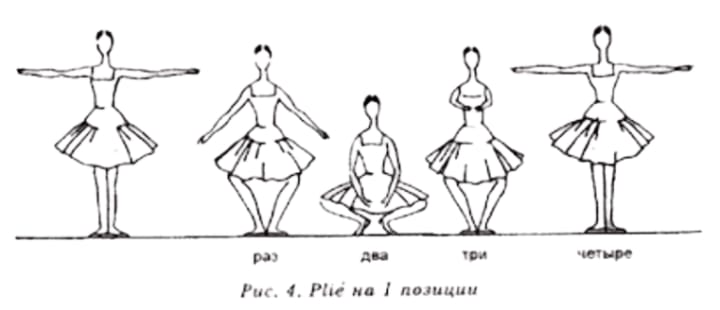
Tendus:
This exercise consists of slowly extending the leg forward, sideways or backward while supporting yourself on the other leg. Tendus (literally tense) help improve leg strength and range of your legs. How to make tendus at home:
- Stand up straight, feet together. Support yourself with one hand.
- Lift your right foot slightly and touch the floor in front of you with your toes.
- Extend your right leg straight ahead and place your foot flat on the floor.
- Keep your torso upright, weight evenly distributed on both legs.
- Bring your right leg back to the starting position, feet together.
- Repeat the movement, this time stretching your right leg out to the side.
- Make sure your foot is flat on the floor and your leg is straight.
- Bring the right leg back to center, feet stay together.
- Repeat the exercise again, stretching your right leg backwards.
- Keep your upper body straight and your weight evenly distributed.
- Bring the right leg back to the starting position, feet staying together.
- Repeat the entire process with the left leg.
Keep your upper body upright and your shoulders relaxed during the exercise. Extend the leg fully and make sure you have a good foot position. The foot should be flat on the floor and the toes should be actively extended. The movements should be controlled and flowing. Breathe calmly and evenly during the exercise. Before you start with Tendus, please watch the video:
Video of Ingrida Ballet Training "Tendu"
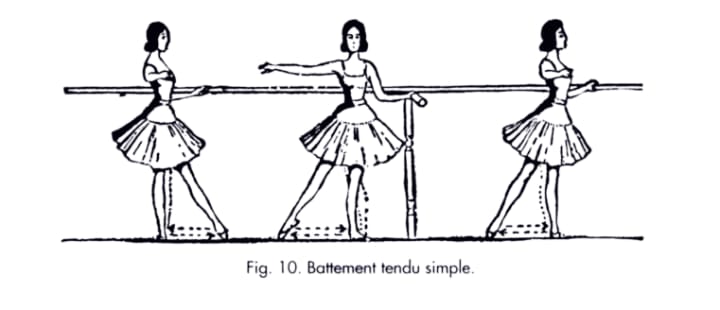
Ronds de jambe:
Ronds de jambe (semi-circular dance step) is a ballet exercise that extends to training leg muscles and posture. To perform ronds de jambe, stand with your back straight and legs straight. Lift the right leg and wrap it in a circle around the left leg while slightly bending the knee and moving the leg back and forth. Repeat the exercise by lifting the left leg and looping it around the right leg.
- Ronds de jambe is a ballet exercise that strengthens leg muscles and improves posture. Always stretch and warm up beforehand to avoid injury
- Start in an upright position, feet together, arms at your sides.
- Slightly lift your right leg and perform a small curve forward.
- Keep the leg straight, then rotate it outward.
- Continue moving your right leg outward in a semi-circular motion.
- Return your right leg back to the starting position.
- Repeat the curve with the right leg, this time backwards.
- Keep the leg straight and rotate it outward.
- Bring your right leg back and complete the semi-circle motion.
- Bring your right leg back to the starting position.
- Repeat the entire exercise with your left leg.
Again, keep your torso upright and your shoulders relaxed, and make sure to keep your straight leg active during the round. Turn the leg outward to create a clean line. Make sure that the moving leg always stays straight and that the foot is straight and the toes point forward. You can increase the difficulty of the exercise by working faster or by raising the movable leg higher. Before you start the exercise, please watch the video for Ronds de jambe:
Video of Ingrida Ballet Training "Rond de Jambe"
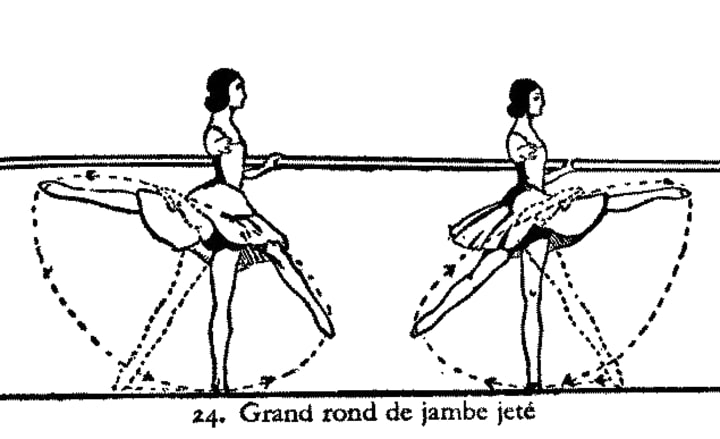
Grand battements:
Grand battements are a ballet exercise that focuses on training leg muscles and posture. To perform grand battements, stand with your back straight and legs straight. Lift the right leg and bring it forward while slightly bending the knee and moving the leg up and down. Repeat the exercise by lifting your left leg and bringing it forward.
- Start in an upright position, feet together, arms at your sides.
- Lift your right leg slightly and stretch it straight out in front.
- Vigorously swing your right leg up while keeping your foot straight.
- Bring the leg back to the starting position in a controlled manner.
- Repeat the movement with the right leg to the side.
- Make sure to keep the leg straight and the foot active.
- Bring the leg back to the starting position.
- Repeat the exercise with the right leg behind you.
- Fully extend the leg and keep the foot straight.
- Bring the leg back to the starting position.
- Repeat the entire process with the left leg.
Make sure to keep the moving leg straight at all times and that the foot is straight and the toes are pointing forward. The movement should be controlled and dynamic. Work on getting a high leg position, but make sure you keep your balance. Before you start with the grand battements, please watch the video:
Video von HowcastArtsRec "Great Beats"
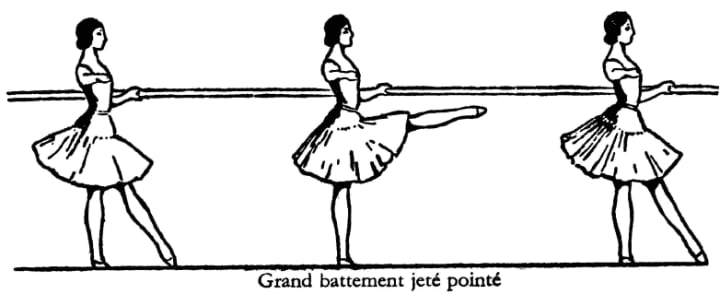
Port de bras:
Port de bras (carrying your arms) is a ballet exercise that works your arm and shoulder muscles and posture.
To perform port de bras, stand with your back straight and legs straight. Raise your arms to your sides and bring them forward while bending them slightly and moving them up and down. Repeat the exercise by bringing your arms back and lifting them to the side again.
- Start in an upright position, feet together, arms hanging loosely at your sides.
- Gently lift your arms out to the side until they are at shoulder height.
- Inhale and gracefully bring your arms forward as if trying to grab something.
- Keep your torso upright and your shoulders relaxed.
- Gently and fluidly extend your arms sideways as if you are laying them on an imaginary surface.
- Keep your arms straight and make sure they stay parallel to the floor.
- Slowly slide your arms back to the starting position.
- Repeat the movement, this time bringing your arms up over your head.
- Make sure your arms stay straight and your shoulders relaxed.
- Gently lower your arms back to your side.
- Repeat the entire process, this time bringing your arms back.
- Keep the movements fluid and maintain good posture.
The following applies here: The arms should be stretched and elegant, the movements gentle and flowing. Concentrate on the expressiveness and beauty of the arm movements and keep your pelvis straight as you practice. Before you start the exercise, please watch the video on Port de bras:
Video of Ingrida Ballet Training "Vaganova's Port de Bras"
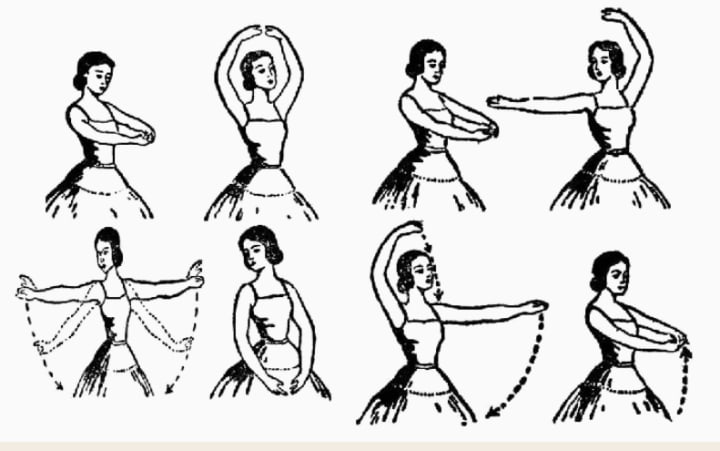
You can find more descriptions of exercises, pictures and videos of the exercises on my website.
About the Creator
Olga Leibrandt
My name is Olia and I'm a ballet teacher at Ballet Studio Ost in Frankfurt Germany specializing in the classical Russian Vaganova method. I've been teaching ballet for 13 years, starting with Children's Ballet Frankfurt in 2009.






Comments
There are no comments for this story
Be the first to respond and start the conversation.